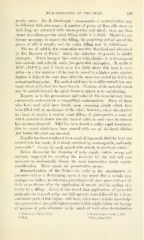Page 441 - My FlipBook
P. 441
MUMMJFICATION OF THE PULP. 439
percha cones. Dr. K. Ottolengui " recommends a method which may
be followed with advantage A number of piews of floss silk about an
:
inch long are saturated with chloro-percha and dried ; these are then
thrust in a chloro-percha canal filling while it is fluid. Should it ever
become necessary to remove the filling, the projecting end of one of the
pieces of silk is caught, and the entire filling may be withdrawn.
The use of salol in this connection was first described and advocated
by Dr. Mascort of Paris.- Salol, the salicylate of phenol, is mildly
antiseptic. When brought into contact with alkalies it is decomposed
into carbolic and salicylic acids, two powerful antiseptics. It melts at
40°C. (104°r.), and if fused at or but little above this heat it crys-
tallizes in a few minutes ; if the heat be raised to a higher point crystal-
lization is delayed for some time after the mass has cooled far below its
normal melting-point. The melted salol may be readily carried into anv
canal which will admit the finest broach. P
Reports as to the permanence and value of this material vary from
enthusiastic endorsement to unqualified condemnation. Many of those
who have used salol have found, upon reopening canals which have
been filled with it, an absence of the salol ; however, where the practice
has been to employ a central canal filling of gutta-percha, a cone of
which material is thrust into the melted salol, in such cases its absence
has not been observed. Salol has been found to suffer rapid decomposi^
tion in canals which have been treated with one of the fixed alkalies
just before the salol was inserted.
Paraffin has been employed for a canal filling,'made fluid by heat and
carried into the canals ; it is bland, unirritating, unchangeable, and easily
removable.^ It may be used, mixed with aristol, in sterilized canals.*
Before discussing the cleansing of pulp canals, certain means and
methods suggested for avoiding the necessity for the toil and care
necessary to mechanically cleanse the more inaccessible canals require
consideration. These agents are preservative pastes.
Mummification of the Pulp.—As early as the introduction of
arsenous oxid as a devitalizing agent it was noted that a certain per-
centage—or rather, an uncertain percentage—of cases gave evidence of
little or no disease after the application of arsenic and its sealing in a
cavity by a filling. Later, it was found that applications of powerful
antiseptics to exposed pulps not infrequently were followed by a long-
continued quiet of that organ ; still later, when more definite knowledge
was possessed of the pathological results which might follow the leaving
of portions of pulp substance in the canals of teeth after devitalization
1 Methods of FiUinxj Teeth. 2 Dental CUmos. 1S94, p. 352.
^ Ibid. * Ibid., June 181)7.


